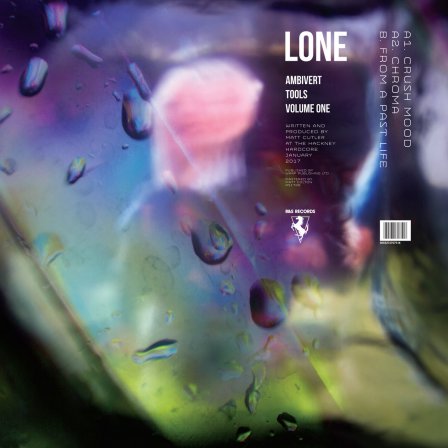What does “free your mind” mean in 2017? I pose this question in good faith. When the sampled phrase comes looping around on “Crush Mood,” the lead track on Ambivert Tools Vol. 1, fading into lockstep with Lone’s breezy, unabashedly feelgood acid-tech, it seems faintly ridiculous: is straightforward techno-utopianism a tenable worldview for the 2017 rave, when the same ideology is used to sell us on the idea that our own precarity is justified? Maybe more striking than this notion is the fact that the phrase basically slips by unnoticed despite its own absurdity — in this context, it fails entirely to signify, as much a textural element as the jazzy detuned synths that inflect the songs on Ambivert Tools Vol 1 with the simulation of an ecstatic positivity.
Lone is the work of Nottingham’s Matt Cutler, and it is unabashedly indebted to the “golden age” of rave. Cutler’s music is often compositionally indistinct from classic house and techno deviations hearkening back to the 1990s and early 2000s, but would seem to theorize a lane for itself via the ultra-compressed precision matrix of digital production software: saturated with high-fidelity synth panorama and gated distortion, Lone’s production specifically on this EP works to cast the listener awash in sweet remembrance for a speculative idée fixe of freedom, the source of which is located in a past beyond the veil of memory.
Dance music label R&S is, for me, a fitting context for this emotional revisionism to occur, as I was first introduced to the label not through its seminal 90s output, but through the non-“primary source” but equally influential rave-inflected R&B of James Blake, specifically his CMYK EP from 2010. That record formed a poignant synthesis between rave’s promise of non-capitalist routes to value-creation and the romantic loneliness and isolation of the digital contemporary. In the years to follow, mainstream culture would internalize this tension as the wellspring of a dominant aesthetic form.
Lone has little to do with this specific aesthetic synthesis, but it does bear resemblance to a kind of blasé singularity located in a specific brand of modern techno-utopianism that eschews the specifics of cultural contexts to the primacy of innovation. FACT writer Christian Eede makes Lone’s tendency toward pastiche a thesis in his review of the artist’s previous record for R&S, 2016’s hardcore-influenced Levitate. Eede offers a graciously moderate and innovation-centric critique of the record, which identifies “forward-thinking” sounds and “the progression of compelling producers and labels” as the salient characteristics of good modern rave music, and henceforth qualifies the Lone record as unsuccessful because it doesn’t “achieve anything beyond merely looking back.”
This clean binary between the past and the future makes for a clean review, but it’s a concept beholden to the same ideology that drives today’s brutally capitalistic techno-utopian class. Eede touches on this concept in his review, declaiming the use of “anti-establishment ideals” to create something “easily marketable” and calling the sound on Levitate “an era neatly packaged with its edges removed,” but he does not bring these comments into the context of a broader materialist critique.
Rave music in its first iteration was a technology of the soul that non-ironically worked off the “free your mind” mantra. Drugs, repetition, and communal movement were harnessed to circumvent conventions of time and labor, the rave event as much a mass pedagogy as it was a design of relations. In this initial context, the technological utopianism of techno was not synonymous with capital accumulation; rather than functioning as a the object of a future luxury fetish, it occupied a distinct political category.
What is rave music now? Still ineluctably political, it is now so not because it slips the category of labor entirely, but because it occupies a position of fixation for capital accumulation while retaining the political idea of “free your mind” in its inherited history. In this sense, the absolute interconnectedness of everything has suffered a turn of disillusionment: it is no longer an aspirational feeling to be cultivated, but an intractable and ever-lurking truth. Ecstasy and iPhones are the most sensorily overwhelming combination I’ve ever found. The imperative “free your mind” gives rise to other questions: To what? To whom? Rave is irrevocably a currency of the commercial self.
Depending on location and cultural context, rave is alternately an antagonist to oppressive nationalistic regimes, a smooth channel for aesthetic interpellation facilitating corporate accumulation of cultural capital, a concept divorced from its context of material enunciation, and a jumping-off point for critical neo-historicisms. These embodied critical iterations of the rave event have formed in a heterogenous manner across a continuum with respect to capital interpellation, with self-aware collapse of the problematic at one end, as in the hysterical sexuality of PC Music, and disavowal or denial of the problematic itself at the other, which is where Ambivert Tools Vol. 1 would seem to lie despite staking a nominal claim to productive ambivalence. In this sense, Lone is a kind of Tame Impala of the Paradise Garage, whose ultimate form is not a form at all, but a vibe. Like chemtrails, the ideology of the vibe is undeniable because it is obvious.
It is true that Lone’s music is essentially just 90s rave rehashed in higher fidelity. The casual euphoria that Cutler cultivates across these three tracks almost seems completely unaware of the fact that time has passed and that the politics of rave have intractably complicated since then, only making note of the passage of time in the sense of software capability progression, which betrays a naive, complacent aesthetic that wouldn’t seem so busted if it weren’t for the unquantifiable volume of brilliant contemporary music that problematizes and makes crucial that very same dynamic.
More about: Lone




